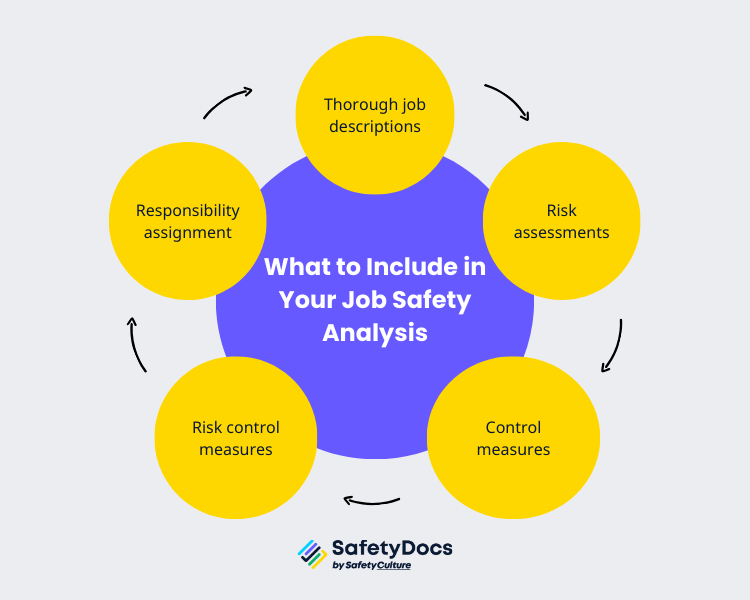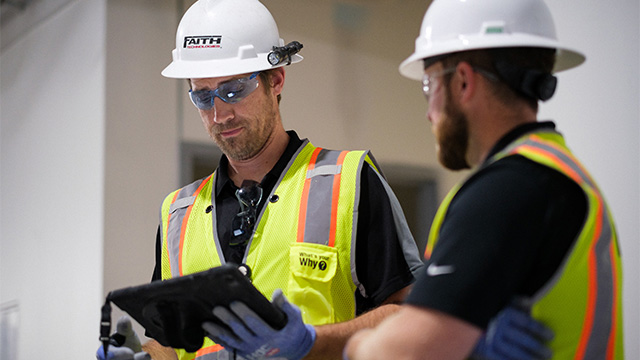A Job Safety Analysis (JSA) is a step-by-step way to look at job tasks to find dangers and figure out the best ways to do the jobs safely. It's a big part of keeping a workplace safe and involves everyone - from the people doing the jobs, the bosses watching over them, to the safety experts helping out.
Think of JSA as a safety check before anything goes wrong. It's about looking ahead, spotting where things could go wrong, and fixing them before they do. But sometimes, mistakes in writing or updating these safety checks can make them less helpful.
This blog is going to talk about how to write a JSA. We'll go over what works best and what common slip-ups to avoid. We're going to show you how getting everyone involved and keeping your safety checks up-to-date makes for a safer workplace. By the end of this, you'll know how to make a JSA that really keeps everyone safe at work.
What is a Job Safety Analysis (JSA)?
A Job Safety Analysis is a process that breaks down job tasks into specific steps and identifies potential hazards associated with each step. A JSA aims to prevent severe or disabling injuries by identifying, assessing, and controlling risks before they occur.
JSA vs JHA
Job Safety Analysis (JSA) and Job Hazard Analysis (JHA) are terms often used interchangeably in workplace safety. Both involve examining job tasks to identify hazards and determine the safest way to perform the work. However, minor differences can depend on interpretation within different industries or organisations.
- Job Safety Analysis (JSA): A JSA typically involves breaking a job down into steps, identifying potential hazards in each step, and determining preventive measures to overcome them. The main focus is the relationship among the worker, task, tools, and work environment.
- Job Hazard Analysis (JHA): A JHA, on the other hand, may sometimes place a slightly stronger emphasis on the analysis of potential hazards that could exist in the workplace. The process is very similar to a JSA. However, the term "hazard" in JHA might suggest a more comprehensive look at workplace hazards, including long-term health hazards like repetitive strain injuries or exposure to harmful substances.
Whether you call it a JSA or a JHA doesn't change the fundamental goal. Let us go over the best practices for drafting a JSA to help you achieve your primary objective: identifying and controlling potential hazards.

Best Practices for Drafting a Job Safety Analysis
1. Involve Employees in the Process
Those who perform the job are often the best source of information about the tasks and their hazards. The involvement of workers in the JSA process improves the quality of analysis and increases their commitment to safety measures. It is crucial to involve employees from all levels, including experienced workers, new hires, and those with disabilities.
2. Determine Which Tasks Need a Job Safety Analysis
Not all tasks require a JSA, so it is essential to identify which jobs are high-risk and need a JSA. These may include non-routine tasks, jobs with a history of accidents or near-misses, and newly introduced tasks.
A JSA is needed for the following tasks:
- Jobs with a high injury rate or potential for severe or disabling injuries, even without a history of previous incidents.
- Jobs new to the operation or have undergone changes in processes and procedures may require additional training and support to ensure successful adaptation and proficiency.
- Jobs with a history of past injuries, a high frequency of safety incidents, a high potential to cause an injury and the potential for increased severity of incidents
- Jobs where an employee has a safety concern. For instance, where there is potential exposure to dangerous chemicals, equipment malfunctions might occur, or safety hazards release energy unexpectedly.
- Jobs that require wearing personal protective equipment (PPE) or following recommended steps to perform a task

3. Know What to Include
The content and extent of information required when composing a Job Safety Analysis still pose a question for many in the workplace. While some organisations have extensive documents that outline the steps necessary to complete a JSA, others ask workers to create a new JSA every day before starting work. Regardless of the approach used, the JSA must reflect its key components.
1. Thorough Job Description
A detailed description of the job, task or procedure being analysed, which includes:
- Job Steps: A list of all steps involved in completing the task, starting from preparation and ending in clean-up.
- List of Potential Hazards: The core purpose of JSA is to identify potential hazards associated with a job task. Risks could be physical (like machinery), environmental (like noise or temperature), chemical, biological, or ergonomic.
2. Risk Assessment
Once all the hazards have been identified, it's time to assess them. Determine the severity and likelihood of each risk. This helps prioritise which hazards need to be addressed first.
Use a risk matrix to map out the likelihood and severity of each hazard, giving it a numerical value or colour code. This makes it easier to identify which hazards need immediate action.
3. Control Measures
After identifying and assessing potential hazards, it's time to implement control measures. Control measures can include engineering or administrative controls, personal protective equipment (PPE), work procedures, training, etc.
4. Risk Control Measures
The third component is a set of procedures and controls to eliminate or reduce risks. These measures may include engineering or administrative controls, personal protective equipment (PPE), work procedures, training, etc.
5. Responsibility Assignment
Assign responsibility for implementing and maintaining each control measure. This ensures accountability and follow-through.
4. Break Down the Job into Steps
When writing a Job Safety Analysis (JSA), list the steps from beginning to end, like writing a recipe. This process involves dissecting a task or operation into smaller, manageable steps. Here's a more detailed explanation:
- List in Steps: Start by describing the job from the beginning to the end as if you're writing a recipe or a manual. Each step should be a distinct part of the job that advances the task towards completion. Avoid making the steps too general or too specific. A good rule of thumb is that most jobs can be described in 5 to 10 steps.
- Use Clear, Concise Language: Write each step using clear, simple language that anyone can understand. It's essential that all employees, regardless of their level of expertise or familiarity with the job, can follow the steps.
5. Review and Update Regularly
Jobs change over time, and so do their associated hazards. Update the JSA to reflect changes in the job process, new equipment, or after an accident or near miss. Regular review and updates ensure that the JSA remains accurate and relevant. It also helps to involve workers in reviewing and updating the JSA as they are familiar with the job tasks and can provide valuable input.
6. Train Workers on How to Use a Job Safety Analysis
Once the JSA is complete, use it to train employees on safe work practices. Properly training workers is crucial for any safety program's success. Ensure that all employees involved in the job understand how to follow the JSA and implement safety measures. Also, train them on what to do in an emergency or unexpected hazard.
7. Document Everything
Finally, document everything related to the JSA. Record each JSA, including who was involved, its completion date, identified hazards, and preventive measures. This documentation can serve as a reference for future revisions and help track the effectiveness of safety measures. It also demonstrates your organisation's commitment to promoting a safety culture.
What to Avoid?
Now that we've discussed a JSA and the best practices for creating one, let's discuss what to avoid.
- Don't rush through the process: Taking your time and thoroughly analysing each job task is crucial. Rushing through the steps can lead to incomplete or inaccurate information, resulting in potential hazards being overlooked.
- Being too vague or too detailed: Each step in the JSA should be distinct and meaningful. Avoid being too ambiguous, as it can miss potential hazards. Conversely, being overly detailed can make the JSA complicated to follow.
- Ignoring input from employees: The workers who perform the job often have the best understanding of what the task involves. Ignoring their input could result in missing critical steps or potential hazards.
- Assuming All Jobs are Low-Risk: Even seemingly simple tasks can have potential hazards. Don't assume that specific jobs or tasks don't require a JSA. It's always better to be safe than sorry.
- Neglecting to consider non-routine tasks: Many accidents occur during non-routine operations. Include maintenance tasks, start-up/shutdown procedures, and emergencies in your analysis.
- Failing to update the JSA: Jobs can change over time with new equipment, processes, or personnel. Failing to update JSAs to reflect these changes can render them ineffective.
- Relying only on personal protective equipment (PPE): While PPE is essential to hazard control, it shouldn't be your only solution. The primary aim should be to eliminate hazards at the source or use engineering or administrative controls where possible.
- Not training employees on the JSA: Once the JSA is complete, it's essential to train all employees who perform the job on the identified hazards and control measures. If they're unaware of the JSA and its contents, they won't be able to use it to protect themselves.
Technology in Implementing JSA
Technological advancement has changed and improved many aspects of our lives, including workplace safety. Here are some ways technology can be used to enhance the implementation of Job Safety Analysis:
- Electronic Document Controls: Digital tools allow for better organisation and accessibility of JSAs.
- Real-Time and Remote Audits: Technology enables real-time, remote audits of JSAs, streamlining the audit process and allowing immediate feedback.
- Data Collection and Analysis: Technology can aid in collecting and analysing data related to job hazards. It can help identify trends, monitor the effectiveness of control measures, and provide insights for continuous improvement.
- Safety Management Software: Such software offers features to streamline and enhance the JSA process. They can guide users through each step of a JSA, making the process more user-friendly and efficient.
- Training Tools: Digital tools like apps, videos, and virtual reality can train employees on safe work practices and familiarise them with the steps in a JSA.
- Digital Safety Documentation: With technology, safety documentation can be easily accessible and up-to-date. They can include JSA forms and templates, hazard identification checklists, and safety procedures.
Make Implementation Easier With SafetyDocs
SafetyDocs by SafetyCulture is Australia's leading provider of safety documentation. Our comprehensive library of templates, including JSA forms and checklists, can help organisations streamline their safety processes. With SafetyDocs, you can:
- Access safety templates, checklists, or forms that are easy to use and customisable
- Easily share documents with team members
- Add your SafetyDoc's templates to your existing management system
- Equip your team with complete industry-specific related content to ensure their safety
- Keep all your safety documentation up-to-date with the latest industry standards and regulations
Explore these related documents today and make implementing a JSA easier and more efficient for your organisation.
- JSEA Template
- Job Hazard Analysis (JHA) - Powered Mobile Plant
- Risk Assessment Form
- High-Risk Work Plan
Start implementing Job Safety Analysis in your organisation today with SafetyDocs. Contact us to learn more about our products and services. Stay safe!
Our team of experts is dedicated to providing accurate and informative content. Craig Cruickshank, our senior HSEQ advisor at SafetyDocs by SafetyCulture has reviewed this blog post to ensure the highest level of quality.
Learn more about Craig's work on LinkedIn for more industry insights.
Available for instant download and supplied in fully editable MS Word format for use in your business.
Please note that the above information is provided as a comment only and should not be relied on as professional, legal or financial advice.
Share This Article

